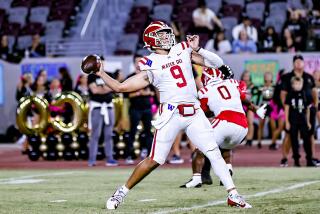High Schools Giving TV Good Review : Prep Sports: While critics question the effect of national television exposure, school officials seem pleased with the results.
- Share via
The annual big game between Carson and Banning high schools, which will be shown live Nov. 9 on cable television to a potential 8.5 million homes across the country, is bigger than ever this year. But is it better?
That’s the question being asked by critics who oppose the TV contract engineered by the National Federation of State High School Assns.--governing body of prep sports--with cable’s SportsChannel America to televise 25 high school events this season, including 12 football games.
Critics say that TV will put additional pressure on players and coaches and expose them to the kinds of temptations that created a monster in the college ranks. As Sports Illustrated’s Rick Reilly complained in a column before the season: “Why does high school America want to go big time when big time has already been proven to smell like old game socks?”
That high school football--basketball starts in December--now has its own national television package shouldn’t surprise anyone who has been following prep sports in the ‘80s.
USA Today calls it “the new age.” Big corporations are paying millions to sponsor state championship events and influence players to wear their products. TV stations are buying rights to local games for as much as $1.5 million a year, and, although the national federation doesn’t recognize them, there are even national football and basketball “champions,” the teams that finish first in USA Today’s rankings.
But with the first season of nationally televised football drawing to a close, have the critics’ fears been realized? What kind of impact have the televised games had on everyone involved? Have TV timeouts compromised the sport? Are local fans staying home to watch in their living rooms? Is anyone? Who besides college recruiters and players’ relatives are watching?
Officials at the national federation send a representative to every telecast and have “not had one negative report,” said Warren Brown, assistant executive director of the Kansas City-based organization. “It’s been a very positive thing.”
So is the $250,000 that the federation is getting in each year of its five-year contract. Brown negotiated that deal with SportsChannel a year and a half ago.
Each school that makes a TV appearance gets $1,200, a token payment that “does not corrupt,” said Dwight Thomas, football coach and athletic director at Escambia High in Pensacola, Fla. “If a coach is going to instigate immoral or illegal practices, he is going to do so without the influence of television.”
Despite the five-year contract, the federation will probably lose money, after paying the production costs of public-service announcements, Brown said. The announcements promote the values of sports participation, the support of local teams, sportsmanship and drug education.
A typical spot: “When you support activities that turn kids into adults, everybody wins.”
The decision to go on national TV “was not a money-driven thing,” said the federation’s Helen Upton. “It’s principle driven,” a chance to show the “good side” of high school athletics.
High school sports became attractive to cable TV because the beast is always hungry. When SportsChannel decided to challenge cable heavyweight ESPN--which has 58 million subscribers--it went from a three-days-a-week service to seven and needed things to show. Look at Carson-Banning as an alternative to Australian football. But nobody really knows if the high school telecasts are catching on, since ratings won’t be available until SportsChannel is in 15 million homes.
SportsChannel, which also televises National Hockey League games, spends only about $50,000 to produce a high school football game but still manages to give each telecast a professional look. Four or five cameras are used, along with instant replay, snappy graphics and close-ups of cheerleaders and fans. The federation, however, will not allow players to be interviewed before or during a telecast.
SportsChannel is permitted to have one 60-second and one 90-second TV timeout each quarter.
The announcers, 24-year-old Bob Papa on play-by-play and analyst Glenn Blackwood, former Miami Dolphin defensive back, provide the basic down and distances along with player tidbits, culled from questionnaires, such as favorite pro player and career goals.
But no blemishes ever show. No mention of players being caught using steroids or having disciplinary problems or going to summer school to regain athletic eligibility. The football experience is presented strictly as a wholesome activity, “a slice of Americana,” says the federation’s John Gillis, who attends most games.
But whose version of Americana?
Escambia Coach Thomas, who likes to say “nobody can out-promote me,” wanted to have a flag-carrying parachutist land on the field before his team’s game against cross-town rival Pine Forest on Sept. 15. It was a promotion he had used before.
“We were going to show America what football was all about,” Thomas said.
But the federation found out and killed the idea. It wanted bonfires and pep rallies, “normal kinds of things,” Thomas said.
“I told them, ‘This is normal for us.’ Boy, we would’ve lit up some people’s eyes.”
Thomas is also involved in what may be the biggest problem in televising high school games: creating a super division of high school teams, as the colleges have done with Notre Dame, USC, Miami and others. But the federation, Gillis says, is aware of that possibility and is taking steps to make sure it doesn’t happen.
“We don’t want to repeat the same teams more than once every four or five years,” Gillis said. “And we’re looking for strong games, not necessarily for great teams. We want good matchups in terms of great traditional rivalries.”
But the decision of which schools get on the tube is being left to SportsChannel, which wants the most attractive games for obvious reasons. This creates an opening for enterprising coaches. When Thomas read a blurb in the federation newsletter last winter about the deal with SportsChannel, he said to himself, “I’m going to go after this for me.”
Thomas lobbied to get Escambia included on the TV schedule. Not only did he write letters to federation officials, but he created a matchup too tempting for Sports-Channel to turn down: Escambia, one of the country’s top teams in 1986, when it had star running back Emmitt Smith, vs. Pine Forest, last season’s and this season’s No. 1 team in the USA Today poll.
“Coaches are competitive,” said Thomas, whose team lost the TV game to Pine Forest, 17-11. “They’re going to see another coach on TV and say, ‘How can I get me on there?’ So they’re going to be working harder and doing more, which will upgrade football.”
SportsChannel’s schedule-maker is Happy Fine, former columnist for an Eastern basketball magazine. Fine didn’t have much time to put together a schedule this season--he wasn’t able to start until last spring--but did talk to prep writers at almost every metropolitan daily in the country.
In the L.A. area, the annual Carson-Banning game--perhaps the most heated rivalry in Southern California--was at the top of everyone’s list, a natural. But Fine also wanted to schedule teams with nationally known blue-chip players, so he picked Cleveland St. Ignatius, the defending state champion in Ohio that has a prize quarterback named Joe Pickens.
College recruiters, of course, are using the national games to scout potential college players. And even though SportsChannel “goes out of its way to avoid hyping a player,” says spokesman Dan Martinsen, it’s difficult not to keep mentioning a player when he’s making tackles all over the field or, in the case of standout linebacker Oliver Gibson of Romeoville, Ill., making tackles and homecoming king.
“The game definitely marketed and promoted our athletes,” Thomas said. “Every college recruiter in the country had his VCR turned on. It’s going to help our players.”
But is there something slightly wrong about this? Are players from schools whose teams haven’t been on television at a disadvantage?
No, said announcer Papa. “Everybody can open up a USA Today to see who’s the best running back.”
So far, no players have been reported slashing their wrists after fumbling on the potentially winning touchdown run on national TV, or acting like a prima donna after getting a fan letter from somebody in Boise.
“Pressure on kids happens without TV,” suggested SportsChannel’s Martinsen.
And there seem to be residual benefits from being on the game of the week. Before their game, Thomas said, the community paid for a face lift at the Escambia stadium to make sure the national audience didn’t see any peeling paint. And in small towns, the mere fact that their game is going out to the nation is a reason for residents to feel good about themselves.
“It’s a real honor for the kids,” said Coach Allan Cox, whose Paducah (Ky.) Tilghman Tornadoes defeated longtime rival Mayfield in September, 16-7. The Paducah Sun treated the telecast reverentially, a headline declaring “SportsChannel Exposes Community Pride,” and the story even quoted a sportswriter who had come to Paducah to do a piece for a big New York newspaper.
Although the Tilghman-Mayfield rivalry goes all the way back to 1911, this year’s game is different, “remembered as the one on national television,” Cox said. And “in a few years, most people won’t even remember the score, just that it was on TV.”
One of the concerns of some high school officials is that fans will stay home to watch a game on television, hurting local gates.
“We’re trying to get people to get out to our games on Friday night,” said Thomas Byrnes, executive director of the California Interscholastic Federation, which belongs to the national federation. “We should be protecting Friday night.”
But there is no evidence that the high schools are being hurt by the TV games. Just the opposite seems to be happening in the towns where the games are played. At Pensacola, for instance, attendance nearly doubled for the Escambia-Pine Forest game because, Escambia Coach Thomas speculated, fans wanted to be there on national TV. Then, he theorized, they went home and watched tapes of the game on their VCRs.
Television definitely creates a new dimension.
“Having the game on TV gives me more incentive to play well,” Carson quarterback Armin Youngblood said.
And, said Thomas: “Who doesn’t want to go on national TV and say ‘Hi, Mom,’?”
More to Read
Go beyond the scoreboard
Get the latest on L.A.'s teams in the daily Sports Report newsletter.
You may occasionally receive promotional content from the Los Angeles Times.










